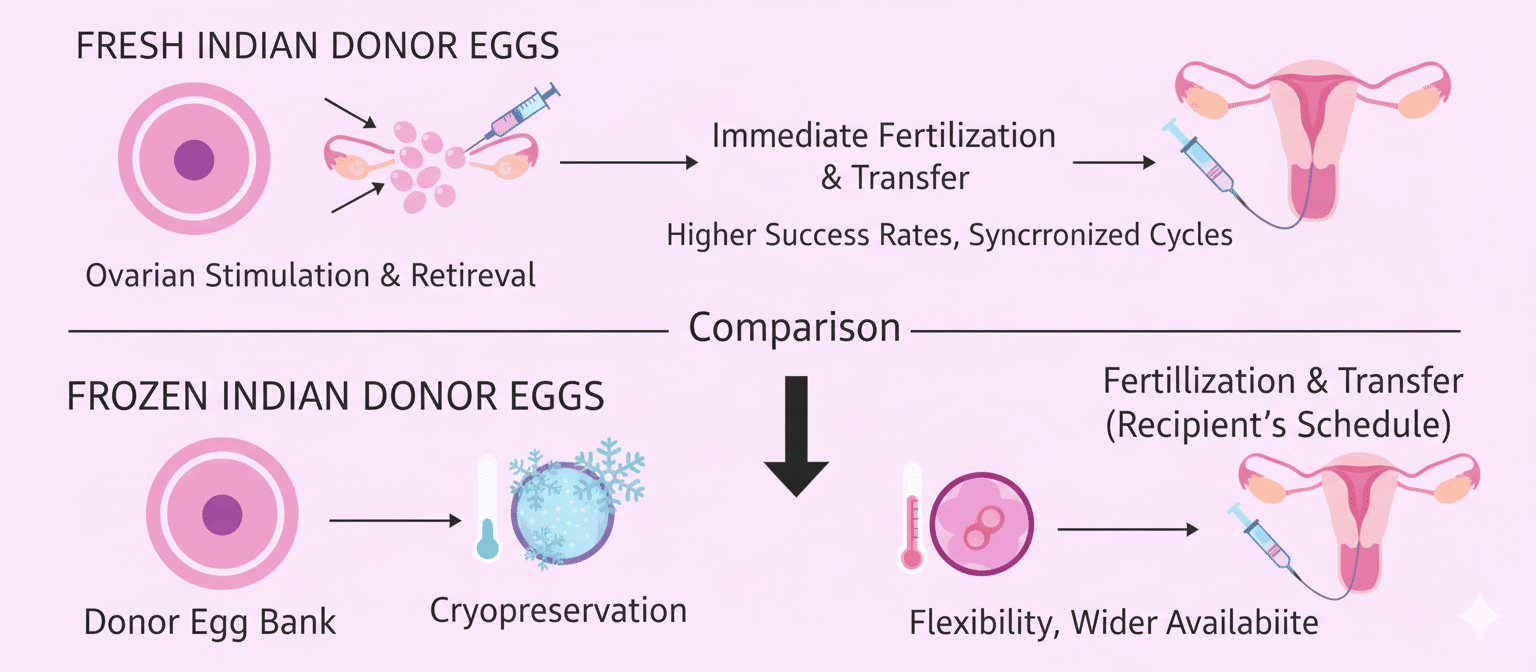One of the first decisions Indian intended parents in the USA face when pursuing egg donation is whether to use fresh donor eggs or frozen donor eggs. Each option has unique advantages, costs, and implications for success rates.
For Indian families, this choice is even more critical due to the limited availability of Indian egg donors in the USA. In this blog, we’ll break down the pros and cons of fresh vs. frozen eggs, with a focus on what Indian parents should consider before deciding.
What Are Fresh Donor Eggs?
Fresh donor eggs are retrieved directly from a donor during a synchronized IVF cycle. The eggs are fertilized immediately with the intended father’s (or donor’s) sperm.
Advantages :
- Higher success rates (fresh eggs tend to produce more embryos).
- Ability to choose the number of eggs retrieved.
- Option for full genetic sibling sets.
Disadvantages :
- Requires synchronization of donor and intended mother/surrogate.
- Longer wait times due to donor cycle coordination.
- Higher costs (compensation + medical + travel).
What Are Frozen Donor Eggs?
Frozen eggs are collected from donors, vitrified (flash-frozen), and stored in an egg bank. Parents can purchase a set number of frozen eggs without waiting for a fresh cycle.
Advantages :
- Immediate availability (no donor cycle synchronization).
- Lower upfront costs compared to fresh eggs.
- More convenient for international parents.
Disadvantages :
- Lower success rates (fewer eggs thaw successfully).
- Limited number of eggs per batch (usually 6–12).
- Less flexibility in donor choice, especially for Indian donors.
Success Rates – Fresh vs. Frozen
- Fresh eggs: 50–70% success rates per cycle at top U.S. clinics.
- Frozen eggs: 50-65% success rates due to thawing losses.
- Indian donors are often preferred in fresh cycles, since families may want two or more sibling sets.
Costs – Fresh vs. Frozen
- Fresh Indian donor eggs: $30,000–$50,000 (including compensation, IVF, legal, travel).
- Frozen Indian donor eggs: $18,000–$28,000 per batch.
- If multiple children are desired, fresh eggs often prove more cost-effective.
Availability of Indian Donors
- Fresh Indian donors: Scarce, but available through specialized agencies like IndianEggDonors.com. Matching may take weeks to months.
- Frozen Indian donor eggs: Extremely limited — only a handful of U.S. egg banks carry Indian inventory. Waitlists are common.
Case Study – Fresh vs. Frozen
Arjun and Meera wanted two children using the same donor. They chose a fresh donor cycle, which produced 18 eggs and 6 embryos. They used one embryo immediately and froze the rest, ensuring siblings.
By contrast, Sanjay and Kavita used frozen donor eggs. Their batch of 7 eggs yielded 2 embryos, leading to one healthy child but no embryos left for future use.
Testimonials
“We chose fresh eggs to ensure we could have siblings in the future. It was worth the wait.” – A.P., Parent, NJ
“Frozen eggs worked for us because we wanted immediate transfer without delay.” – R.S., Parent, CA
FAQ
Q: Which is cheaper, fresh or frozen eggs?
Ans : Frozen eggs are cheaper upfront, but fresh eggs may be more cost-effective long-term if siblings are desired.
Q: Are frozen Indian donor eggs easy to find?
Ans : No, they are extremely limited in U.S. egg banks. Most Indian parents opt for fresh cycles.
Q: Do success rates differ by ethnicity?
Ans : Success rates depend more on egg quality and clinic lab standards than ethnicity, but availability of Indian donors is lower.
Q: Can I combine fresh and frozen eggs?
Ans : Some families use frozen eggs first, then pursue a fresh cycle if they want additional embryos.
Conclusion & Call to Action
Both fresh and frozen Indian donor eggs offer pathways to parenthood, but the best choice depends on your family goals, timeline, and budget. For Indian intended parents, fresh cycles remain the most popular due to success rates and sibling options.
Ready to find your Indian donor and explore fresh or frozen options?

Dr. Pooja Patel
Dr. Pooja Patel is a Chief Surrogacy Coordinator at Surrogacy4all. She has 10 years of experience in Anesthesiology and critical care medicine.
She received her medical degree from Seth GS Medical College and K.E.M Hospital in India. She then completed an internship. She finished her Anesthesia residency at Grant Govt Medical College and JJ Group of Hospitals in India.










